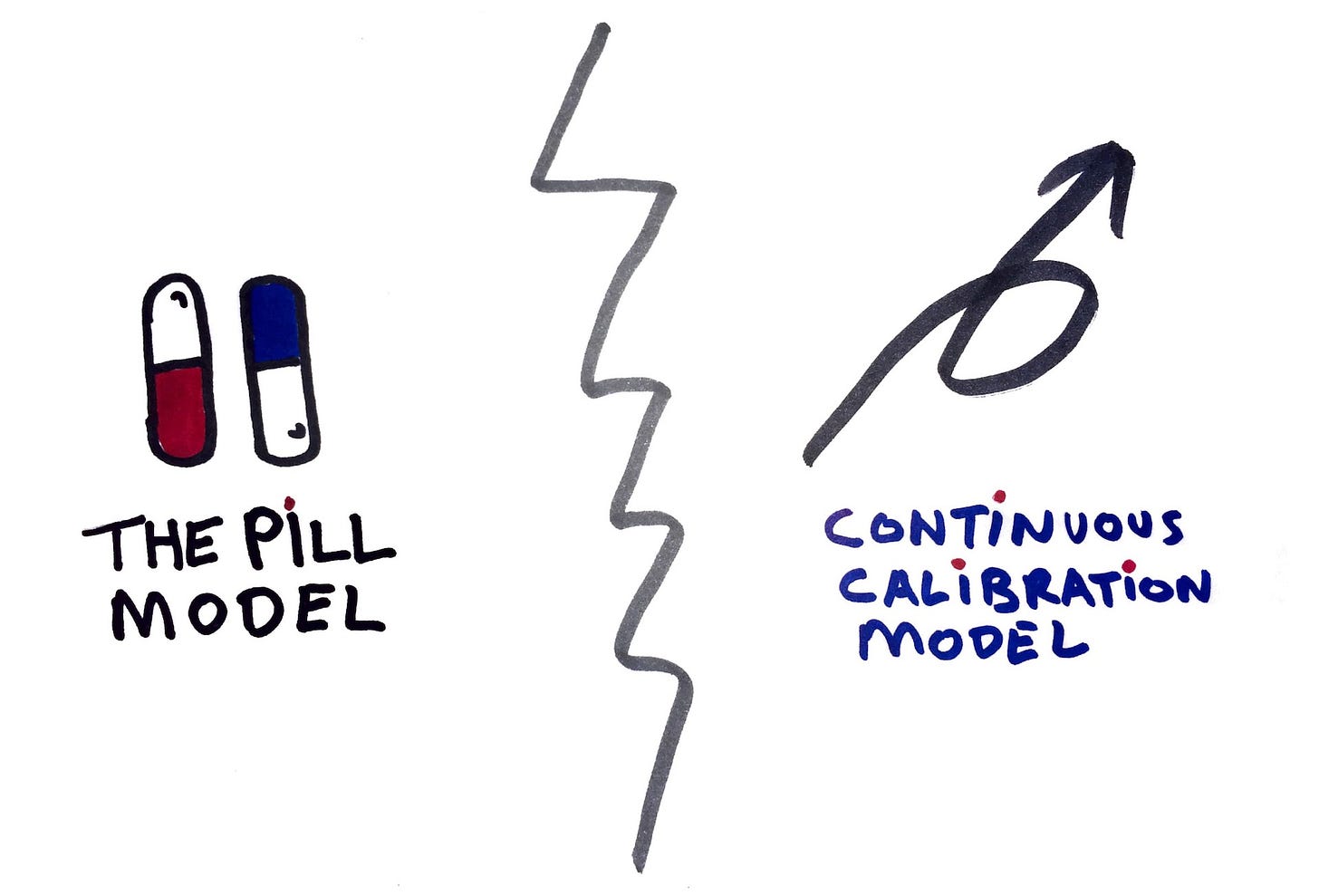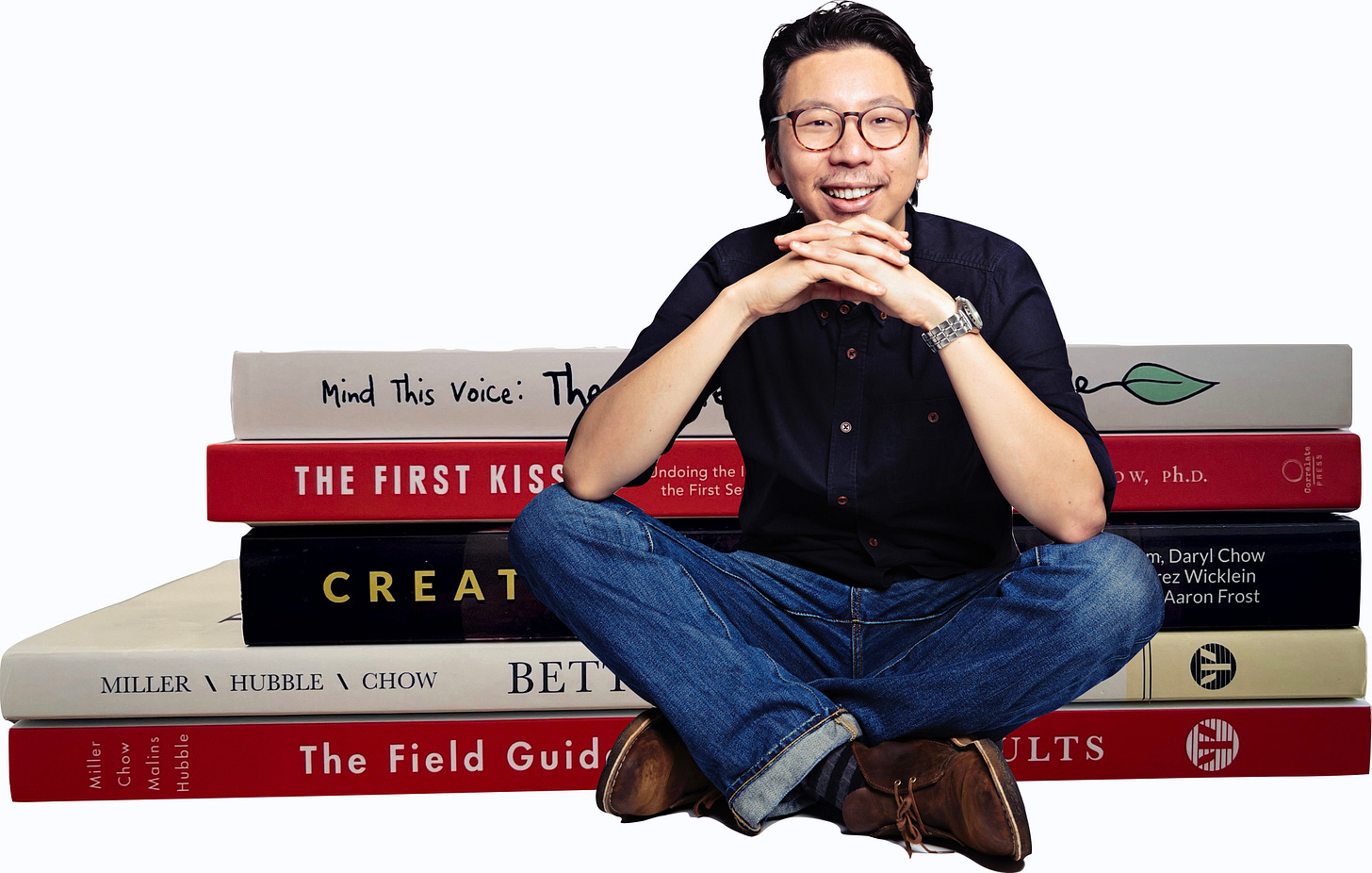When The "Pill Model" Doesn't Work #204 ⭕️
What's right may not be right for you, and the trappings of misreading research.
Best practice is not always best.
Most studies are based on the average of a given group. For instance, when a treatment effect is found, it means that the average treatment group is better off than the average control group. In other words, not everyone benefits.
But let’s consider the following absurd example: if you take five 10 year old, and take another five 50 year old and gather all ten of them, tally the average age, and you do everything to cater for 30-year-olds, you’d quickly realise that there is no such person in the room.
Stepping out of the roomful of kids and mid-life audience, in Chapter 3: Client Factors of our edited book, The Field Guide to Better Results, Joshua Swift and Jesse Owen highlighted a good example of when we fall into the trappings of ecological fallacy, that is, whenever inferences are made about an individual based on aggregate data from a group.
For example, a research study could be conducted with 100 female clients over the age of 70 with generalised anxiety disorder. After the administration of a specific 12-week treatment, 85% of them show clinically significant change.
Now, a 75-year-old woman with generalised anxiety disorder comes into a therapist’s office seeking help, and the therapist decides to use that research-supported 12-week treatment. Some might guess that the chance of treatment success for this woman is 85%; however, her chance of recovery is actually unknown. [emphasis mine]
There is no way to tell if she had been in the research study on the treatment, if she would have been one of the 85% who recovered or one of the 15% who did not.
This scenario usually stumps most therapists.
Swift and Owen explains:
If the same therapist were to apply this treatment to 100 women over the age of 70 over the course of a year, we could assume that around 85% of them would recover and 15% would not. But, we would have no idea which individual woman would fall into which category.
And so it is critical that we make decisions based on the individual client and not the client disorder, age, gender, ethnicity, sexuality, or any other demographic or group characteristic or any combination of such.
As a word of caution, Nassim Taleb says,
Don’t cross a river if it is (on average) four feet deep.
A Video from Measured
Above is one the 21 videos taken from the course, Measured, a primer on how to integrate Feedback Informed Treatment (FIT) into your clinical practice.
I rarely promote this course, but if you are interested to quickly jump-start on the use of FIT in your work, this practical guide, along with clinical examples and succinct tips will help you through efficiently.
If you are an individual who is interested, it’s a pay-for-what you want pricing. Drop us an email at admin@darylchow.com and we will help you get straight into the program.
Pill Model vs Continuous Calibration Model
As spelled out in the video above, let’s quickly look at the difference between two ways of thinking, what I call the Pill Model vs. The Continuous Calibration Model.
Pill Model
In the curriculum design of training mental health professionals, I believe we adopted a limiting mental model called the pill model.
The pill model says:
There’s a right way of delivering treatment from the outset: what works for whom
You stick to the method, increase adherence to protocol, and do not adjust the treatment for fidelity’s sake
Scale the solution and evaluate the effectiveness of the therapy method using pre- and post-therapy outcome measures.
Fundamentally, we’ve made a conflation that social interventions should work like medical interventions, yet evidence suggests that adherence to a treatment modality does not improve outcomes (Owen & Hilsenroth, 2014; Webb, DeRubeis, &Barber, 2010).
Think about this and remember the models of psychotherapy that we are taught from school on. A pioneering therapist found his own way of working and went on to create a variant of “train the trainers” to scale his theory about humanity and design specific approaches to the rest of the world.
We may try to imitate Aaron Beck, the Marsha Linehan, the Peter Levine... And what happens? We typically see a decline effect in terms of actual client outcomes.
Information is not education. You wouldn’t bet on inspirational transformation when content knowledge is the only staple. We need something more for the conversational art form of therapy.
Continuous Calibration Model
Instead of the pill model which predetermines what works for whom, we should take a continuous calibration approach.
We must strive to fit the individual, not the average.
The pill model is a limiting mental model of curriculum design in training mental health professionals. Generally, the social sciences have been misled by this notion, which assumes that social interventions should work like medical interventions.
The continuous calibration model says:
There isn’t a predetermined “right” way.
You are encouraged to tweak and recalibrate, not simply to stick to the model.
Use timely data, so as to adapt and learn, session-by-session.
SEE RELATED:
#8. There's a Really Good Reason Why We Need Adjustable Seats
In the 1950s, A fairly unusual be-spectacled and slender Lieutenant Gilbert Daniels was tasked to solve one of the biggest problems in the US Air Force: Plane crashes. What he unravelled in the process holds a unique lesson for psychotherapists, and why we have been failing to implement and scale "evidence-based" practices as we try to fit the "average …
In 1985, in her last interview with Richard Simon from Psychotherapy Networker, Virginia Satir was asked what she thought about the neurolinguistic programming (NLP), which was modelled after her, Fritz Perls and Milton Erickson’s approach to therapy:
I would not want to learn NLP, if you want to know the truth . I am not sure if I could learn it.
Perhaps that is what Carl Rogers meant when he said he was not a Rogerian or when Carl Jung said
Thank God I’m Jung, and not a Jungian.
There is no manual for this: everyone’s therapeutic style is an uncharted terrain.
Legendary psychiatrist Milton Erickson said,
Develop your own technique. Don’t try to use somebody else’s technique. . . Don’t try to imitate my voice or my cadence. Just discover your own. Be your own natural self. It’s the individual responding to the individual. . . I’ve experimented with trying to do something the way somebody else would do it. It’s a mess!
Go your own road. In fact, tweak, adjust, and calibrate as you go, and grow your own road.
Notice Board
We have 2 seats left for the Deliberate Practice, DP Cafe group.
Join Scott Miller and I for four intimate sessions of small group meetings, each organised around your questions and goals with instruction and coaching provided by the group,
For more details and dates, see here.
Daryl Chow Ph.D. is the author of The First Kiss, co-author of Better Results, The Write to Recovery, Creating Impact, and the latest book The Field Guide to Better Results. Plus, the forthcoming new book, Crossing Between Worlds.







I loved this! I feel the last part is an important reminder for all those psychotherapist out there feeling like imposters, looking for a million trainings but may need some slowing down and exploration of if what they are doing work?
Thanks Daryl! The continuous calibration model/contextual model, as said by Eliabet below, is just plain good sense. Therapists must adapt our work according to the feedback form each unique client. Unfortunately we know that good sense and common sense are not that common in our field.